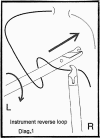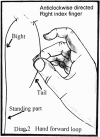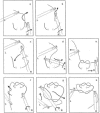Endoscopic suturing and knot tying: theory into practice
- PMID: 11685022
- PMCID: PMC1422098
- DOI: 10.1097/00000658-200111000-00004
Endoscopic suturing and knot tying: theory into practice
Abstract
Objective: To advance modern surgical techniques of endoscopic knot tying, encompassing a new appreciation of knot-tying theory and the application of second-generation, purpose-designed instruments.
Summary background data: During open surgery, surgeons automatically create the surgical half-hitch by using either instrument or hand/finger knot-tying methods (figure 4). Each of these methods, which are mirror images of each other, forms the same result, the half-hitch. Two opposing half-hitches are needed to form a square knot. There are many ways for new-generation instruments to create a secure square knot during endoscopic surgery. An overview of the current endoscopic knot-tying methods is presented.
Methods: The author presents a theoretical analysis of square knot-tying techniques as applied during instrument and hand/finger movements. The application of a mirror-image concept was considered in the analysis of these two contrasting methods.
Results: There are 12 ways to create a square knot, some of which have previously not been described or needed in open surgery. Some of these methods have particular application in endoscopic surgery.
Conclusions: A new understanding of knot-tying theory has been developed, with innovative methods being defined for tissue approximation during endoscopic surgery. These ergonomic, efficient, and contrasting methods of knot tying are described using second-generation endoscopic instruments. The new techniques have direct and broad application in many fields of minimally invasive surgery.
Figures









References
-
- Cuschieri A, Szabo Z. Tissue approximation in endoscopic surgery. ISIS Medical Medial, 1995.
-
- Ferzli GS. Laparoscopic Instrument. U.S. Patent 005147 373, 1992.
-
- Noda WA. Dual Function Suturing Device, Method. U.S. Patent 005211650A, 1993.
-
- Murphy DL. Endoscopic knot tying made easier. Aust NZ J Surg 1995; 65: 507–509. - PubMed
-
- Murphy DL. A new method of laparoscopic instrument knot tying. Surgical Technology International IV 1995; 4: 199–202. - PubMed
MeSH terms
LinkOut - more resources
Full Text Sources
Medical

